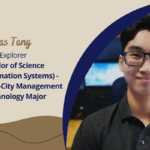[Feature image: (L-R) Chong Yun Yu, Lim Shen Jie (Jeff), Brendan Ong Sin Kai, Christal Poon, Heng Bing Chow and Jessica Low Hui Chen]
By the SMU Social Media Team
Traffic lights that connect with cars and sensors to manage congestion; smart waste management systems that minimise overflowing bins and automatically suggest collection timings; laser particle sensors that detect air quality—such technology-enabled tools are employed by smart cities worldwide to optimise efficiency and convenience for their citizens. But beyond improving the quality of life, smart city technology can also help save lives—especially during a pandemic.
Singapore has been lauded for employing technology in fighting Covid-19, such as the TraceTogether app which uses smartphones to aid contact tracing. Ranked the world’s smartest city, the island state continues to make waves in using tech to combat the deadly pandemic. Beyond the adoption of digital tools for the sake of being tech-savvy, the Covid crisis amplified the need for leveraging innovation for powerful social impact.
Last year, the Urban Redevelopment Authority (URA) worked with a group of SMU School of Computing and Information Systems (SCIS) students majoring in Smart-City Management & Technology (SMT) to explore the design and redesign of public spaces in Paya Lebar Central during and after the pandemic.

The open air plaza in Paya Lebar Central provides ample public space for residents nearby
The SMT Major is a unique interdisciplinary programme that aims to develop skills by integrating the key success ingredients: Technology, Social Sciences and Management, for innovating smart city solutions.
The Smart City Project requires the students to work with a real-world industry sponsor, perform a research project or carry out an entrepreneurial effort. Students will either be required to innovate new solutions or conceptualise a smart city application idea before delivering a solution.
By conducting surveys and analysing the results to define what the public perceives as safety in public spaces, the group of SMU Year 3 students— Brendan Ong Sin Kai, Chong Yun Yu, Christal Poon, Heng Bing Chow, Lim Shen Jie (Jeff) and Jessica Low Hui Chen— employed tools picked up in the Analytics Applications in Smart Living module to propose approaches to URA for the design of public spaces in Paya Lebar Central.
“Before the pandemic, Singaporeans—us included—took public spaces for granted,” admit the SMT majors.
“Public spaces are an important part of the built environment and are important to our mental, physical and social wellbeing. With the extensive increase of our time at home during the pandemic, public spaces became especially crucial for retaining a semblance of normalcy to many Singaporeans, allowing us to exercise, breathe some fresh air (and it was truly fresh with the reduced air traffic we got), and enjoy the open space.”
Problem solving in a pandemic
Over a year has passed since the Covid-19 outbreak was first detected in Singapore, and the pandemic has drastically changed our community, lifestyle and social fabric— in many cases, for good.
As such, URA tasked the team with examining how the pandemic has impacted public spaces, and engineering innovative ways to design such spaces to prepare for possible future outbreaks. Every team was also granted full autonomy to approach the project by determining the project scope. Significantly, they were empowered by breakthrough tools in data analysis to develop a solution for the problem statement.
“Our team decided to pursue the problem statement related to designing safe public spaces in a post-Covid-19 era, as we felt that it was a once-in-a-lifetime opportunity to be doing research related to a pandemic with a global effect,” say the students.
“The mentors from URA gave a briefing to provide deeper insights into how their job impacts the environments that we live in and take for granted every day.”
Apart from basic data analytics that was picked up during the Analytics Foundation module, Dr Tan Kar Way, Associate Professor of Information Systems (Practice) and Director of the MITB (Analytics) Programme, equipped the students with technical skills about text analytics, such as Sentiment Analysis, Topic Modelling and Classification, which were heavily applied to the project.
Sentiment analysis is a process that helps determine if a piece of writing is positive, negative or neutral. It is a useful tool to gauge public opinion, conduct nuanced market research, monitor perception, and understand user experiences.
“With Sentiment Analysis, our team was able to derive a ‘score’ using the survey responses that we collected, which was used to define the general public’s perception of public spaces during a pandemic,” share the project members.
Performing sentiment analysis, topic modelling, data analytics and machine learning on their on-the-ground survey results allowed the team to understand the public’s needs and wants for public spaces. This enabled them to develop the S.A.F.E Framework, which frames the management of public spaces in times of a pandemic, in terms of cleanliness (Spick & span), action (Adapt & act), facilities (Facilities for safety) and environments (Environment for everyone).
“Encompassing short- to long-term, and small- to large-scale solutions, our framework details how public spaces should be managed during a pandemic, and as we transition from a pandemic-state to normal-state,” say the students.
Overcoming unprecedented challenges
A project with such tangible real-world implications also came with a unique set of obstacles, one of which is the constraint in finding articles and research papers detailing how other countries and cities, successfully or otherwise, utilised public spaces in a pandemic situation.
“This course ran from August to December 2020, and at that time there was still very limited literature available for us to examine,” recalls the team.
“Nonetheless, extensive research proved fruitful, and we managed to find some examples of how cities in different countries managed public spaces during this trying time. These literature reviews helped us to understand what other cities in the world were doing to combat the pandemic, and to make public spaces safer for everyone.”

The team virtualised a S.A.F.E. framework using outdoor examples at Paya Lebar Central
Besides traditional academic reviews, urban planners of today are also armed with technological advances like AI and machine learning, which leverages computer algorithms to make sense of data. Data analytics has become integral to changing our understanding of how cities work and is a powerful enabler for building people-centric spaces.
After many trials with various algorithms and techniques, the SMU team eventually decided to build the most optimal model using the Decision Tree Classification Model to determine the different perceptions of being ‘safe’.
And while industry projects usually involved a for-profit business owner, the stakeholder for this Paya Lebar Central undertaking took the form of policy makers instead.
URA, being the national urban planning authority of Singapore, formulates strategic plans to achieve a quality living environment.
“Due to the agency’s unique position and the domain of work that URA is responsible for, our team had to make conscious decisions to tailor our findings to our target audience” say the team members.
“Nonetheless, it was rewarding to find that our work is relevant and useful to URA at the end of our project.”
City planning for the new normal
The world over, public spaces were dramatically redefined during the pandemic, and played a critical role in impacting quality of life and even mental health preservation during times of social distancing or a lockdown.
“We initially thought utilising public spaces during the pandemic was about individual choice and freedom, but we realised public spaces played a greater role as a Covid-19 management strategy,” reveals the team.
Through their research, the students learnt that Denmark intentionally utilises public spaces to combat the physical and mental stress that arose from the pandemic, allowing its residents to collectively care for one another while enjoying physical activity and fresh air.
“We also learnt from our survey responses that while many Singapore residents chose to stay at home during the pandemic, they still craved social interactions and going out,” add the students.
As such, some of the recommendations from the project involved an increase in the number of green spaces accessible to the public and allowing for more ways to view greenery even from within buildings. And as much as these urban planners of tomorrow have on hand a suite of technological tools to future-proof our cities, the students stress the importance of deeper engagement with the citizens to whom they cater for.
“Technology alone can only turn a city ‘digital’, it is the people that make it ‘smart”, add the students.
“Technology is the enabler of harnessing knowledge from the people, but the responsibility lies in people to turn these raw data into meaningful insights.”
[All photos courtesy of Chong Yun Yu]
Create your digital future with SMU. Learn more about our Bachelor of Science (Information Systems) programme today!









